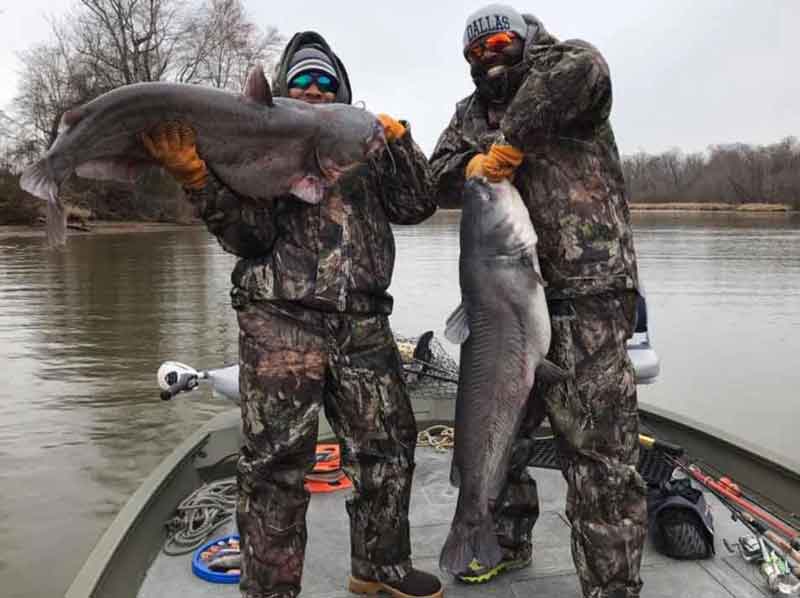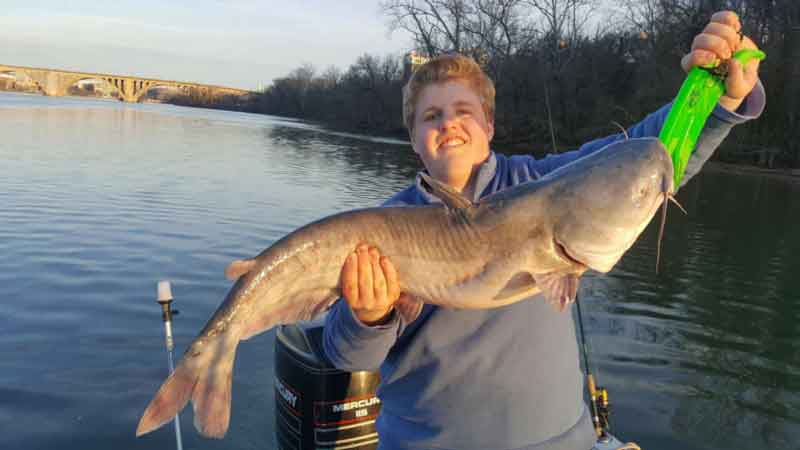We love fishing for some species because of the challenge, we love fishing for others because of their tail-walking antics, and we love fishing for some because of their beauty, but those are all rather unlikely reasons to go fishing for catfish. It’s more a matter of size and brute strength that attracts us when it comes to the big blues, though many are interested in their good numbers and excellent food value when it comes to the smaller ones. Any way you cut it, this impressive invasive gives us anglers a gigantic bulls-eye to shoot for.

Blue Catfish Fishing Basics
While chasing blue catfish in the Western Shore tribs is not an incredibly complex fishery, making sure you cover the basics is important. Beyond that there are some tricks and tips that will help you boost your numbers and perhaps find that trophy fish. To get things started:
- Gear – Either spinning or conventional gear is fine, though most blue cat sharpies stick with conventional set-ups. Rods choice is more important than reel choice, because you’ll need stout tips so you can drag big fish away from the snags and snarls they often live around. In any case most folks lean heavy in this fishery, and use 30 or 40 pound gear and line at least that heavy.
- Rigging – Dedicated catfish anglers all have their own specific favorite rigging tweaks, but few will argue that this basic rig won’t get the job done: Start off with a circle hook in the 8/0 to 10/0 range (even a 12/0 is not out of line if you want to target real monsters, huge though it may appear). Tie it onto a three-foot 50 to 80 pound test leader, and tie a barrel swivel on the other end. Run your main line through a two- or three-ounce egg sinker, then tie it to the barrel swivel. In high current areas many anglers prefer to use “fish finder” style rigs, with the line running through a plastic tube attached to a swivel clip, where you attach your weight. This allows you to clip on flat or teardrop-shaped weights, which roll less and won’t get washed into snags as often.
- Baits – Anglers will endlessly argue over which bait is superior, often depending on where they’re from. On the James and the Rappahannock, fresh-cut gizzard shad is a common favorite. On the Potomac you’ll see many people using cut menhaden or herring. It’s not uncommon to see city and suburban anglers using strips of chicken breast, or chicken livers, in all of the above. At times, particularly in tidal creeks feeding lower sections of the rivers, live bull minnow are an excellent bait. Some who target the biggest beasts and are searching only for the true trophies prefer live sunfish, and others swear by big shrimp purchased at the seafood store.
- Location – Depending on which river you’re fishing and how far up it you may be, you’ll be looking for either holes and/or channels. As a rule of thumb, deep spots surrounded by shallower water is a winner. Look to the outside bends, areas where creeks meet the rivers, and where bridges go across. Structure is a big bonus; like many species, blue catfish like laying in and around sunken trees, bridge pilings, rubble, and boulders. They’re also inclined to find areas where they have shelter from a strong current, so in moving waters, big boulders or similar eddy-creating features are prime.
- Tactics – This is the easy part, folks: fan-cast cast your baits, put the rods in holders, leave the reels in freespool with the clicker on or with a very light drag, and wait. When fishing near structure try to place your baits where they’re up-current of the snags. The catfish will smell your offerings and leave their hidey-holes to find them.
- Turning Bites into Hook-Ups – Now comes the tricky part. Sometimes cats will eat and be done with it, but other times they’ll play with a bait for an absurdly long time before actually eating it all the way. If you grab your rod and start reeling the moment the tip jiggles, you’re likely to pull the bait away from the fish. You need to let it eat until it moves off, and takes a substantial amount of line. Just how much line? It’s a judgement call, and a big part of making the right judgement depends on just where you’re fishing. If you’re around a lot of structure and you wait too long, the fish may go right back into that snaggy hidey-hole you tempted it out of and tangle your line. If you’re in a lot of current, it’s easy to over-judge just how far off the fish has moved since taking the bait. You have to take factors like these into account, and vary your actions depending on how many bites you get and how many you miss.
Blue Catfish Trophy-Hunting Tips
You want to catch the river monster of a lifetime? That’s quite possible, in the Western Shore Bay tribs. The James has produced at least one documented fish that broke the 100-pound mark, and Maryland’s state record (sitting at 84 pounds), was caught in the Potomac. Blues are a bit newer in the Susquehanna and true trophies aren’t (yet) prevalent here, and while the Rap had a banner decade for monster blues in the 90s, these days the average fish aren’t quite so massive. So if size matters above all else, the James and Potomac rivers would be the top rivers to choose.

- Use big baits. A trophy-sized blue catfish will have no problem sucking in a three-pound chunk of meat, much less a trophy-sized sunfish. You have to recognize that your numbers will go down – way down – but when you do get a bite you can bet it’ll be from a behemoth.
- If you’re catching lots of 10-pounders, leave. Even a 10-pound fish isn’t going to feel comfortable hanging around a river monster, and the really giant fish are usually loners. So if you’re catching lots of mediums or smalls, there probably aren’t any gigantic fish in that location at the moment.
- During the summer months, consider fishing at night. Big blues can get a bit lethargic when water temps exceed 80-degrees, and won’t move around much to look for food when the sun’s up.
- Look for spots where all the prime requirements come together: deep water, snaggy structure, and shelter from the current. Focus your efforts there and don’t worry about it if you’re not catching lots of smaller fish – that’s not the point. In fact, it’s a good sign because it may mean there’s one big ruler of the roost down there.
- Some trophy hunters who are uber-confident in their boat-handling skills will actually troll super-slow (a fraction of a mph) for big blue cats using very large (eight-plus ounces) weights that keep their lines nearly vertical. It’s a tall order, especially around snaggy bottoms, but this allows them to offer their baits with pinpoint precision.
Smoked Blue Catfish Delights
Recipe courtesy of Potomac River blue catfish fan Gary Lengerhuis.

“My favorite way to cook them is in the smoker,” says Gary. “Fillet and skin the meat, and place them in this brine overnight.”
- 3 cups soy sauce
- 1/4 cup Worcestershire sauce
- 1 tablespoon garlic powder
- 1 tablespoon onion powder
- 1 tablespoon Old Bay
- 2 tablespoons black pepper
- 1 cup brown sugar
“After brining, pat the fillets dry and then let them air dry to allow a pellicle (sticky surface) to form. Set your smoker to 225-degrees, and smoke the fillets for 2.5 hours with apple and pecan wood.”